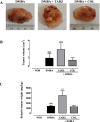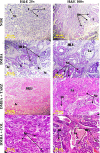Oral administration of tartrazine (E102) accelerates the incidence and the development of 7,12-dimethylbenz(a) anthracene (DMBA)-induced breast cancer in rats
- PMID: 34972512
- PMCID: PMC8720219
- DOI: 10.1186/s12906-021-03490-0
Oral administration of tartrazine (E102) accelerates the incidence and the development of 7,12-dimethylbenz(a) anthracene (DMBA)-induced breast cancer in rats
Abstract
Background: Despite the considerable advances made in the treatment of cancer, it remains a global threat. Tartrazine (E102) is a synthetic dye widely used in food industries; it has recently been shown to induce oxidative stress (a well known risk factor of cancer) in rat tissues. The present work therefore aimed to assess the impact of a regular consumption of tartrazine on the incidence of breast cancer in rats.
Methods: Forty (40) Wistar rats aged 55 to 60 days were randomly assigned into 5 groups (n = 8) including two groups serving as normal controls and receiving distilled water (NOR) or tartrazine (NOR + TARZ). The three remaining groups were exposed to the carcinogen DMBA (50 mg/kg) and treated for 20 weeks with either distilled water (DMBA), tartrazine 50 mg/kg (DMBA + TARZ) or a natural dye (DMBA + COL). The parameters evaluated were the incidence, morphology and some biomarkers (CA 15-3, estradiol and α-fetoprotein) of breast cancer. The oxidative status and histomorphology of the tumors were also assessed.
Results: A regular intake of tartrazine led to an early incidence of tumors (100% in rats that received TARZ only vs 80% in rats that received DMBA only), with significantly larger tumors (p < 0.001) (mass = 3500 mg/kg and volume = 4 cm3). The invasive breast carcinoma observed on the histological sections of the animals of the DMBA + TARZ group was more developed than those of the DMBA group. The increase in serum α-fetoprotein (p < 0.05) and CA 15-3 (p < 0.01) levels corroborate the changes observed in tumors. The presence of oxidative activity in animals of the DMBA + TARZ group was confirmed by a significant decrease (p < 0.001) in the activity of antioxidant enzymes (SOD and catalase) as well as the level of GSH and increase in the level of MDA compared to the rats of the DMBA and NOR groups.
Conclusion: Tartrazine therefore appears to be a promoter of DMBA-induced breast tumorigenesis in rats through its oxidative potential. This work encourages further studies on the mechanisms of action of tartrazine (E102) and its limits of use.
Keywords: 7,12 dimethylbenz(a) anthracene, alpha-fetoprotein; Breast cancer; CA 15–3; Oxidant; Tartrazine.
© 2021. The Author(s).
Conflict of interest statement
The authors declare that there are no conflicts of interest regarding the publication of this paper.
Figures




Similar articles
-
Chemotherapeutic effect of tangeretin, a polymethoxylated flavone studied in 7, 12-dimethylbenz(a)anthracene induced mammary carcinoma in experimental rats.Biochimie. 2014 Apr;99:96-109. doi: 10.1016/j.biochi.2013.11.017. Epub 2013 Dec 1. Biochimie. 2014. PMID: 24299963
-
Synthetic progestins differentially promote or prevent 7,12-dimethylbenz(a)anthracene-induced mammary tumors in sprague-dawley rats.Cancer Prev Res (Phila). 2010 Sep;3(9):1157-67. doi: 10.1158/1940-6207.CAPR-10-0064. Epub 2010 Aug 10. Cancer Prev Res (Phila). 2010. PMID: 20699413 Free PMC article.
-
Exposure of Sprague-Dawley rats to a 50-Hertz, 100-microTesla magnetic field for 27 weeks facilitates mammary tumorigenesis in the 7,12-dimethylbenz[a]-anthracene model of breast cancer.Cancer Res. 1999 Aug 1;59(15):3627-33. Cancer Res. 1999. PMID: 10446973
-
Daucosterol from Crateva adansonii DC (Capparaceae) reduces 7,12-dimethylbenz(a)anthracene-induced mammary tumors in Wistar rats.Environ Toxicol. 2020 Oct;35(10):1125-1136. doi: 10.1002/tox.22948. Epub 2020 May 25. Environ Toxicol. 2020. PMID: 32449848
-
7,12-Dimethylbenz(a)anthracene as a Model for Ovarian Cancer Induction in Rats.Biology (Basel). 2025 Jan 14;14(1):73. doi: 10.3390/biology14010073. Biology (Basel). 2025. PMID: 39857303 Free PMC article. Review.
Cited by
-
Effects of Tartrazine on Some Sexual Maturation Parameters in Immature Female Wistar Rats.Int J Environ Res Public Health. 2022 Aug 21;19(16):10410. doi: 10.3390/ijerph191610410. Int J Environ Res Public Health. 2022. PMID: 36012044 Free PMC article.
-
Vegan Red: A Safer Alternative to Synthetic Food Dyes?Toxics. 2025 May 28;13(6):447. doi: 10.3390/toxics13060447. Toxics. 2025. PMID: 40559920 Free PMC article.
-
Investigation of the Relationship Between Brown HT Dye Exposure and Mammary Tumor Development in Female Rats: An Assessment of the Potential Risk of Breast Cancer.Cureus. 2024 Nov 9;16(11):e73351. doi: 10.7759/cureus.73351. eCollection 2024 Nov. Cureus. 2024. PMID: 39659309 Free PMC article.
-
Safety of tartrazine in the food industry and potential protective factors.Heliyon. 2024 Sep 19;10(18):e38111. doi: 10.1016/j.heliyon.2024.e38111. eCollection 2024 Sep 30. Heliyon. 2024. PMID: 39381230 Free PMC article. Review.
-
Oral Intragastric DMBA Administration Induces Acute Lymphocytic Leukemia and Other Tumors in Male Wistar Rats.J Exp Pharmacol. 2022 Feb 25;14:87-96. doi: 10.2147/JEP.S349047. eCollection 2022. J Exp Pharmacol. 2022. PMID: 35241938 Free PMC article.
References
-
- Sarkar B, Ullah A, Islam S, Hossain S. Anticancer potential of medicinal plants from Bangladesh and their effective compounds against cancer. J PharmacognPhytochem. 2019;8:827–833.
-
- Bray F, Ferlay J, Soerjomataram I, Siegel RL, Torre LA, Jemal A. Global cancer statistics 2018: GLOBOCAN estimates of incidence and mortality worldwide for 36 cancers in 185 countries. CA Cancer JClin. 2018;68:394–424. - PubMed
-
- Siegel RL, Miller KD, Jemal A. Cancer statistics, (2018) CA Cancer J Clin. 2018;68:7–30. - PubMed
-
- Zingue S, Atenguena EO, Zingue LL, Tueche AB, Njamen D, Nkoum AB, Ndom P. Epidemiological and clinical profile, and survival of patients followed for breast cancer between 2010 and 2015 at the Yaounde General Hospital, Cameroon. Pan Afr Med J. 2021;39:182. doi: 10.11604/pamj.2021.39.182.26866. - DOI - PMC - PubMed
-
- Lalloo E, Evans DG. Familiar breast cancer. Clin Genet. 2012;82:105–114. - PubMed
MeSH terms
Substances
LinkOut - more resources
Full Text Sources
Research Materials

